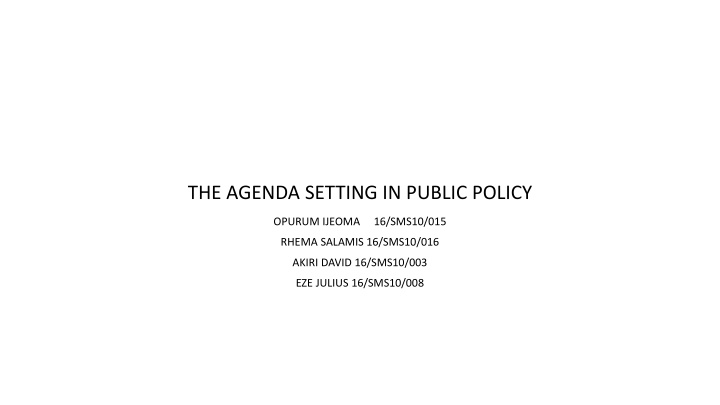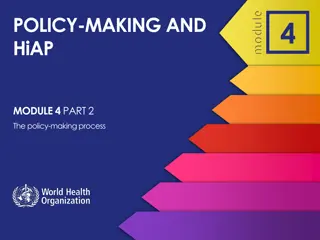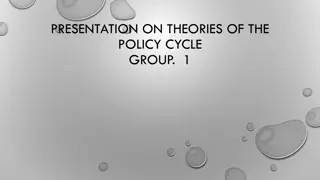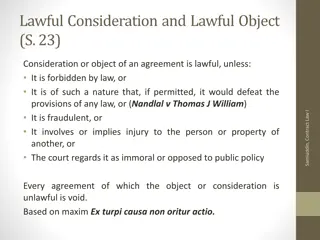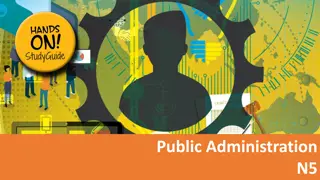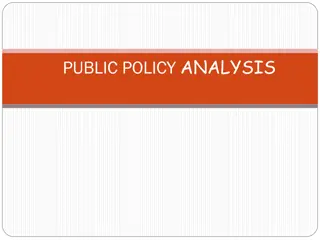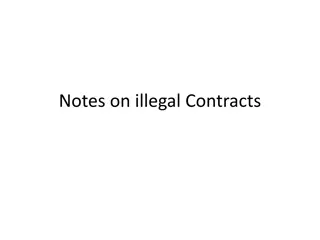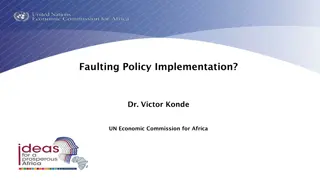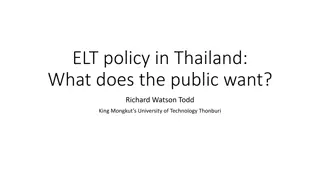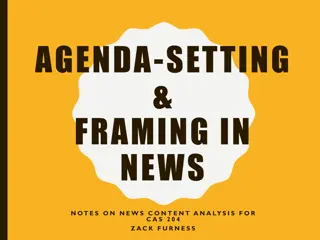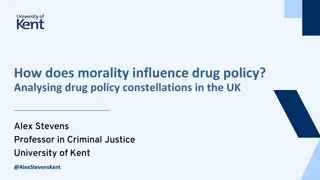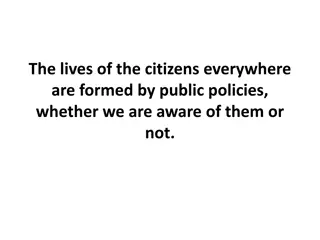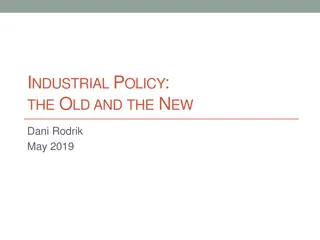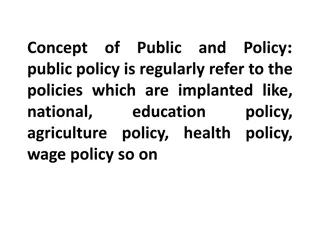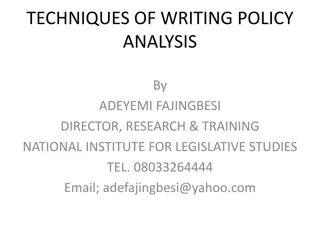Agenda Setting in Public Policy
Agenda setting is a crucial process in public policy where issues and potential solutions compete for attention both from the public and elites. It involves the prioritization of problems and ideas that are brought to the forefront of governmental agendas. Agendas exist at various levels of government, ranging from the systemic agenda to the agenda universe, encompassing all potential ideas within a society or political system.
Download Presentation

Please find below an Image/Link to download the presentation.
The content on the website is provided AS IS for your information and personal use only. It may not be sold, licensed, or shared on other websites without obtaining consent from the author.If you encounter any issues during the download, it is possible that the publisher has removed the file from their server.
You are allowed to download the files provided on this website for personal or commercial use, subject to the condition that they are used lawfully. All files are the property of their respective owners.
The content on the website is provided AS IS for your information and personal use only. It may not be sold, licensed, or shared on other websites without obtaining consent from the author.
E N D
Presentation Transcript
THE AGENDA SETTING IN PUBLIC POLICY OPURUM IJEOMA 16/SMS10/015 RHEMA SALAMIS 16/SMS10/016 AKIRI DAVID 16/SMS10/003 EZE JULIUS 16/SMS10/008
Agenda setting is the process by which problems and alternative solutions gain or lose public and elite attention. Group competition to set the agenda is fierce because no society or political institutions have the capacity to address all possible alternatives to all possible problems that arise at any one time (Hilgartner and Bosk 1988). Groups must therefore fight to earn their issues places among all the other issues sharing the limited space on the agenda or to prepare for the time when a crisis makes their issue more likely to occupy a more prominent space on the agenda. Central to understanding agenda setting is the meaning of the term agenda. An agenda is a collection of problems, understandings of causes, symbols, solutions, and other elements of public problems that come to the attention of members of the public and their governmental officials. An agenda may be as concrete as a list of bills that are before a legislature, but also includes a series of beliefs about the existence and magnitude of problems and how they should be addressed by government, the private sector, non-profit t organizations, or through joint action by some or all of these institutions.
Agendas exist at all levels of government. Every community and every body of government Congress, a state legislature, a county commission has a collection of issues that are available for discussion and disposition, or that are being actively considered. All these issues can be categorized based on the extent to which an institution is prepared to make an ultimate decision to enact and implement or to reject particular policies. Furthest from enactment are issues and ideas contained in the systemic agenda, in which is contained any idea that could possibly be considered by participants in the policy process. Some ideas fail to reach this agenda because they are politically unacceptable in a particular society; large-scale state ownership of the means of production, for example, is generally off the systemic agenda in the United States because it is contrary to existing ideological commitments.
The largest level of the agenda is the agenda universe, which contains all ideas that could possibly be brought up and discussed in a society or a political system. In a democracy, we can think of all the possible ideas as being quite unconstrained, although, even in democracies, the expression of some ideas is offi cially or unoffi cially constrained. For example, in the United States, aggressively racist and sexist language is usually not tolerated socially in public discourse, while Canada has laws prohibiting hate speech and expression. Canada s laws are unlikely to be copied and enacted in the United States because they would likely conflict with the First Amendment of the United States Constitution.
Indeed, sometimes people paint policy ideas with terms intended to place these ideas outside the realm of acceptable discussion. For example, health care reforms that would involve an increase in government activity are often dismissed as socialized medicine, with the threat of socialism invoked to derail the idea. In a democracy that prizes freedom of speech, however, many ideas are available for debate on the systemic agenda, even if those ideas are never acted upon by governments.
If a problem or idea is successfully elevated from the systemic agenda, it moves to the institutional agenda, a subset of the broader systemic agenda. The institutional agenda is that list of items explicitly up for the active and serious consideration of authoritative decision makers (Cobb and Elder 1983, 85 86). The limited amount of time or resources available to any institution or society means that only a limited number of issues is likely to reach the institutional agenda (Hilgartner and Bosk 1988; O Toole 1989). However, institutions can increase their carrying capacity and can address more issues simultaneously (Baumgartner and Jones 2004; Talbert and Potoski 2002), either when there are many pressing issues, or when resources or technology are available to manage this increased load.
POLITICAL POWER IN AGENDA SETTING POLITICAL POWER IN AGENDA SETTING The ability of groups acting singly or, more often, in coalition with other groups to infl uence policy is not simply a function of who makes the most persuasive argument, either from a rhetorical or empirical perspective. We know intuitively that some groups are more powerful than others, in the sense that they are better able to infl uence the outcomes of policy debates. When we think of power, we might initially think about how people, governments, and powerful groups in society can compel people to do things, often against their will. In a classic article in the American Political Science Review, Peter Bachrach and Morton Baratz argue that this sort of power the ability of actor A to cause actor B to do things is one of two faces of power. The other face is the ability to keep a person from doing what he or she wants to do; instead of a coercive power, the second face is a blocking power.
All forms of political organization have a bias in favor of the exploitation of some kinds of confl ict and the suppression of others because organization is the mobilization of bias. Some issues are organized into politics while others are organized out. (Schattschneider 1960/1975, 71) In other words, some issues are more likely to reach the agenda because the bias of the political system allows them to be raised, while others are, according to the bias of the system, unfit for political consideration. Housing, education, a job, or health care are not provided as a matter of right in America because the bias of the American political system rests on cultural values of self-reliance, which means that the United States lags behind other nations in the state provision of these services. This bias is not static or God-given, but changes rather slowly as some interests oppose the provision of these things as a matter of right.
In the first face of power, A participates in the making of decisions that affect B, even if B does not like the decisions or their consequences. This is the classic sort of power that we see in authoritarian or totalitarian regimes, but we can also see this sort of power in the United States and other democracies, because there are many groups that have very little power to influence decisions made on their behalf or even against their interests. Prisoners, for example, have little power to influence the conditions of their sentencing and incarceration, while minors have little say in policies made on their behalf or in their interests, such as policies infl uencing education or juvenile justice. This is not to say that other people and groups do not speak for prisoners or minors. But these spokespeople are working on behalf of groups that are either constructed as helpless or deviant (Schneider and Ingram 1993).
In the second face of power, A prevents Bs issues and interests from getting on the agenda or becoming policy, even when actor B really wants these issues raised. Environmentalism, for example, was, until the late 1960s and early 1970s, not a particularly powerful interest, and groups that promote environmental protection found that their issues rarely made the agenda because these issues in no way were those of the major economic and political forces that dominated decision making. Not until the emergence of high-profi le environmental crises, such as the revelation of the problems with the pesticide DDT or the Santa Barbara oil spill of 1969, were these problems coupled with broad-based group mobilization, thereby elevating these issues to where mainstream actors paid attention to it. Even then, one can argue that actor A, representing the business and industrial sector, bent but did not break on environmental issues and is still able to prevent B, the environmental movement, from advancing broader (or radical, depending on one s perspective) ideas that could have a profound effect on the environment.
Other scholars of political power have conceived of a third face of power, which differs substantially from the second face of power in that large groups of people who objectively have a claim that they are disadvantaged remain quiescent that is, passive and fail to attempt to e xert their infl uence, however small, on policy making and politics. This is the story John Gaventa tells in his book Power and Powerlessness (1980, 168).
THE SOCIAL CONSTRUCTION OF PROBLEMS AND ISSUES Problems can be defined and depicted in many different ways, depending on the goals of the proponent of the particular depiction of a problem and the nature of the problem and the political debate. The process of defi ning problems and of selling a broad population on this defi nition, is called social construction. Social construction refers to the ways in which we as a society and the various contending interests within it structure and tell the stories about how problems come to be the way they are. A group that can create and promote the most effective depiction of an issue has an advantage in the battle over what, if anything, will be done about a problem.
The way a problem is defined is an important part of this persuasive process and is important in the choice of solutions. The social construction of a problem is linked to the existing social, political, and ideological structures at the time. Americans still value individual initiative and responsibility, and therefore make drinking and driving at least as much a matter of personal responsibility as social responsibility. The same values of self-reliance and individual initiative are behind many of our public policies, dealing with free enterprise, welfare, and other economic policies. These values differentiate our culture from other nations cultures, where the community or the state takes a more important role. In those countries, problems are likely to be constructed differently, and different policies are the result.
MEASURING AGENDA STATUS OF ISSUES MEASURING AGENDA STATUS OF ISSUES In a volume on policy analysis it is important to understand how we analyze the status of issues on the agenda. We can do so both qualitatively and quantitatively, and the way we approach this analysis is clearly infl uenced by the nature of the questions we ask. The two basic categories of questions are What is on the agenda? and What is the agenda status? of any particular issue. It is probably easiest to measure issues on the national institutional agenda, because the Congress and executive branch have historically kept remarkably good records, and because these records have been put into databases that are reasonably easily searched. Thus, a researcher can use the Congressional Information Service (CIS) index to track the substance of Congressional hearings, the Library of Congress s THOMAS database to track legislation or debate in the Congressional Record and various legal research tools to review and track rulemaking in the Federal Register.
Fortunately, a great deal of the work of involved in gathering and categorizing important agenda information has been achieved under the auspices of the Policy Agendas Project at the Center for American Politics and Public Policy at the University of Washington. The goal of this project is to provide a base of agenda data, using a comparable coding scheme over time and between the different agendas or arenas, that researchers can use to study agenda setting. The founders of this effort intended for these databases to be extended, supplemented, and studied in greater depth by researchers.
The study of agenda setting is a particularly fruitful way to begin to understand how groups, power, and the agenda interact to set the boundaries of political policy debate. Agenda setting, like all other stages of the policy process, does not occur in a vacuum. The likelihood that an issue will rise on the agenda is a function of the issue itself, the actors that get involved, institutional relationships, and, often, random social and political factors that can be explained but cannot be replicated or predicted. But theories of agenda setting, coupled with better and more readily available data, are enabling researchers to understand why and under what circumstances policy change is likely to occur.
